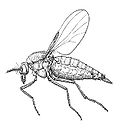| Ceratopogonidae Temporal range: | |
|---|---|
 | |
| A female biting midge, Culicoides sonorensis | |
| Scientific classification | |
| Kingdom: | Animalia |
| Phylum: | Arthropoda |
| Class: | Insecta |
| Order: | Diptera |
| Suborder: | Nematocera |
| Infraorder: | Culicomorpha |
| Superfamily: | Chironomoidea |
| Family: | Ceratopogonidae Newman, 1834 |
| Subfamilies and tribes [1] | |
| |
Ceratopogonidae is a family of flies commonly known as no-see-ums, sand flies or biting midges , generally 1–3 millimetres (1⁄16–1⁄8 in) in length. The family includes more than 5,000 species, [2] distributed worldwide, apart from the Antarctic and the Arctic. A 2025 study from Oxford University lists the subspecies Ceratopogonidae midges as "the most widely recognised and best-studied cocoa pollinators." [3]
Contents
Ceratopogonidae are holometabolous, meaning their development includes four life stages: egg, larva, pupa, and imago or adult. [4] Most common species in warmer climates will take about two to six weeks to complete a life cycle. Both adult males and females feed on nectar. Most females also feed on the blood of vertebrates, including humans, to get protein for egg-laying. Their bites are painful, and can cause intensely itchy lesions [5] due to the body producing histamines against the proteins from the midges' saliva. [6] [7] Their mouthparts are well-developed for cutting the skin of their hosts. Some species prey on other insects.
Larvae need moisture to develop, but also air and food. They are not strictly aquatic or terrestrial. [5]
Some species within the biting midges are thought to be predatory on other small insects. In particular, mosquito larvae have been investigated as common prey for biting midges in the genus Bezzia . For example, experiments have been conducted on the species Bezzia nobilis that suggest their reliance on mosquito larvae as one source of prey. [8] [9] They can also be hematophagous parasites of invertebrates, depending on whether the bloodsucking attack is fatal. [10]
Like other bloodsucking flies, Culicoides species can be vectors of disease-causing pathogens. Among diseases transmitted are the parasitic nematodes Mansonella , bluetongue disease, African horse sickness, epizootic hemorrhagic disease, arboviruses, [11] and nonviral animal pathogens. [12]
Historically, numbers were managed with the insecticide DDT [5] as with Leptoconops torrens populations in California. They can be trapped by luring them with carbon dioxide. Most midges are small enough to pass through ordinary insect window screening. They can be repelled with DEET, [5] oil of Eucalyptus , or Icaridin. Their larvae have also been shown to be susceptible to treatment with commercially available preparations of Bacillus thuringiensis israelensis . [13]




